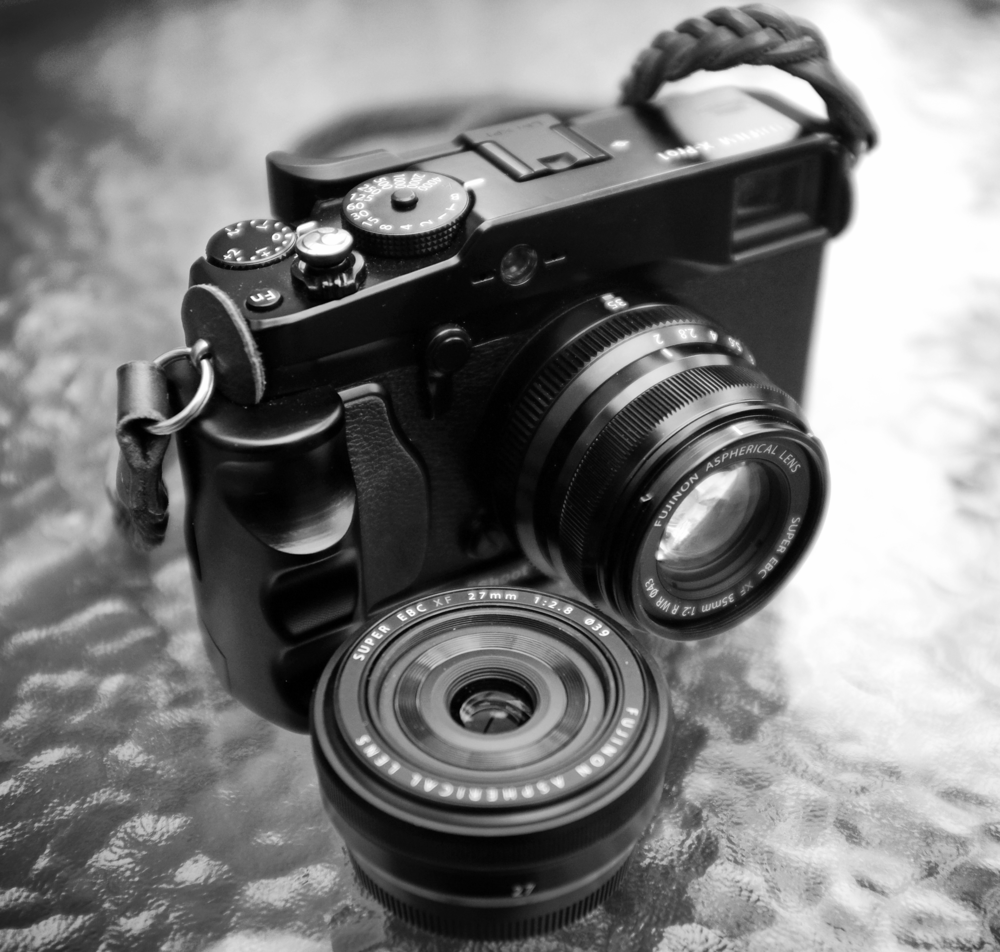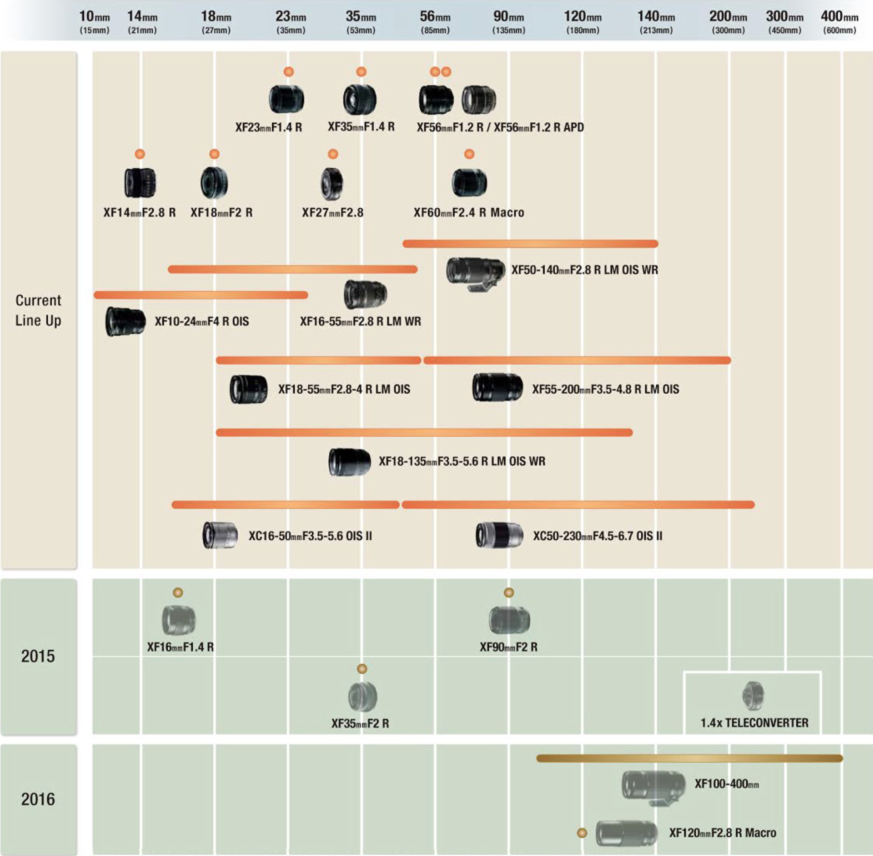
Now, despite what you may read elsewhere, Fuji themselves have not updated their X-System lens roadmap for over 12 months. The current published roadmap does not go beyond 2016 and only shows one lens still to come: The XF 120mm f2.8 macro. This is only to be expected; they’ve brought out 20 lenses and a teleconverter in the past five years so one could argue that they are entitled to rest on their laurels a bit.
…except that’s not what I think is happening.
If you look critically at the current lineup, you can make some logical deductions. These are not rumours, by the way—I leave that to others—simply extrapolations combined with a bit of informed guesswork.

The current range has expanded rapidly to offer something for pretty well everyone, at every price point. From 10mm to 400, from a penny shy of £1399 (the 100-400) all the way down to £299 (35mm f/2, 27mm f/2.8, 50-230mm XC), the X-mount lens range could now be described as comprehensive. From snapper to pro, most photographers could find a lens or two to meet their needs.
XC Future
There are two and a half sub-sets, in effect. The XC lenses (16-50 and 50-230) are built to be inexpensive “entry” models that go well with the cheaper cameras in the range and offer an on-ramp to the X-System. They have plastic mounts and modest apertures but punch well above their weight in terms of performance. I have the 50-230mm and I, and other photographers of my acquaintance, rate it highly as a lightweight travel lens. It was also, until the advent of the 100-400, the longest lens in the line-up so I suspect it is in more widespread use than you might think.
The more substantial lenses bear the designation XF. A select few of the more recent models are also designated WR, for weather-resistant. That’s where I get my “half” from. They are well-made, highly usable, high performance lenses that are the equal—if not the superior—of their rivals.
So what next? I think we will see two distinct initiatives.
Firstly, I’ll go out on a limb here and say that the XC range is largely complete. I can’t see any further investment in the cheaper end of things beyond the occasional tweak. There’s a decent focal length range catered for (16-230mm) and the cheaper XF primes (27 and 35mm) give some speed at a budget, so I shall declare the XC range done and dusted.
XF newbies
The XF range, by comparison, has plenty of life left in it, and scope for more. Initiative one, therefore, will be some new glass to fill a couple of gaps. I suggest we will see:

- A 23mm f/2 as a companion to the well-received 35mm f/2. I expect it to bear a visual similarity, with that tapering look so reminiscent of a Summicron, together with the WR designation. I’ve long wanted a Fuji X set that was the equivalent of the old Leica kit I used to carry everywhere: “The holy trinity” of 35/50/90mm that could do almost anything you wanted. There’s nothing wrong with the current 23mm f1.4, of course—it delivers superlative results —but it is a porky beast and a lot of weight to carry all day long, particularly if like me 23mm isn’t a natural focal length for you. I would be surprised if we didn’t see this new f/2 before the end of the Summer, and at a keen price point comparable to the 35mm f/2.
- A mid-speed 50mm, say f/2, again WR. This may or may not be a macro lens to replace the aging 60 (see below) but would again provide a slimmer alternative to the 56, and cover a classic focal length not currently catered for—75mm in old money. There are many who use legacy 50mm lenses on the X bodies who I am sure would welcome a native mount, AF version to round out their kit.
- A long tele prime, perhaps 500mm, with an aperture around the f5.6 to f8 point. This would be a cheaper, lighter alternative to the top end of the 100-400 for those who don’t need the zoom but do want the reach and don’t want to carry “the beast” around all day.
Initiative two will be a revamp of some of the current range. Over a period of time I expect to see Mk 2 versions of some favourites—the 18mm f/2, 35mm f/1.4 and 60mm f/2.5 are all looking long in the tooth compared with the new boys and could benefit from some fettling of AF motors plus that useful WR designation. Also ripe for the WR treatment would be the 10-24mm, to give a go-anywhere wide-angle partner to the 16-55mm and 50-140mm to go with the X-T2 when it arrives.

Teleconverters
Now, I haven’t mentioned teleconverters. I’m still smarting from the disappointment of the 1.4x converter. It works with only two lenses—TWO. A small 1.4 booster in the corner of one’s camera bag is always welcome but if Nikon, to name one, can produce a 1.4x converter that works with more than a score of their lenses why can’t Fuji do something similar? I get that the laws of physics are immutable, but Nikon are either from Gallifrey or they have found a way to reduce their impact that has thus far eluded Fuji. I’m not asking much, but a Mk.II that offered compatibility with even just the 90mm would be nice.
That said, I also expect we will see a 2x converter that will be a bit more flexible in it’s application and will fit on more lenses. It will also be WR, but as with all such devices will come with a 2 stop light loss (physics again) so will be less usable in the great scheme of things.

Timescales? I expect a revamped roadmap is imminent, and the lenses I have called out will be included. Fuji tends to work (publicly at least) to an 18-month timeframe so I’d expect to see at least two new lenses in 2016 (not including the already-announced 120mm) and some of the Mark II versions starting to appear from Q4 onwards.
Again, I reiterate, these are informed predictions based upon an extrapolation of facts, NOT rumours. No little bird has whispered in my ear, no chickens have been disembowelled and their entrails examined in the production of this article. Fuji inspire loyalty in their employees and testers such that actual leaks of verifiable information are more rare than a sunny day during Wimbledon week—either that or they have some draconian NDAs and very hot lawyers.
What do you think?
- All photographs by Bill Palmer. You can find more from Bill Palmer at Lightmancer
- Subscribe to Macfilos for free updates on articles as they are published. Read more here
- Want to make a comment on this article but having problems? Please read this


I bought the 100-400, it’s a good lens but boy is it heavy! I’m returning it and hoping for a lighter long prime from Fuji in future.
Gerald, if weight is an issue, have a look at the 50-230 XC reviewed elsewhere on this site. It is a great travel lens offering tremendous "bang for the buck" and was, until the advent of the 100-400, the longestlens in the Fuji X-Series system. Also, if primes are your thing, why not go legacy…? A nice Olympus 200mm can be picked up really cheaply.
A 23mm f2 would be heaven for those of us who love 1) that POV and 2) want a smaller load to run about with. Those who come to Fuji X cameras from the world of DSLRs always wonder what the fuss is about: Fuji XF lenses are already soooo much smaller/lighter than DSLR lenses they say. Yes, true… but if your weapon of choice has been a Leica you know what I am writing about!
Excellent prognostications and spot on!
Hank R